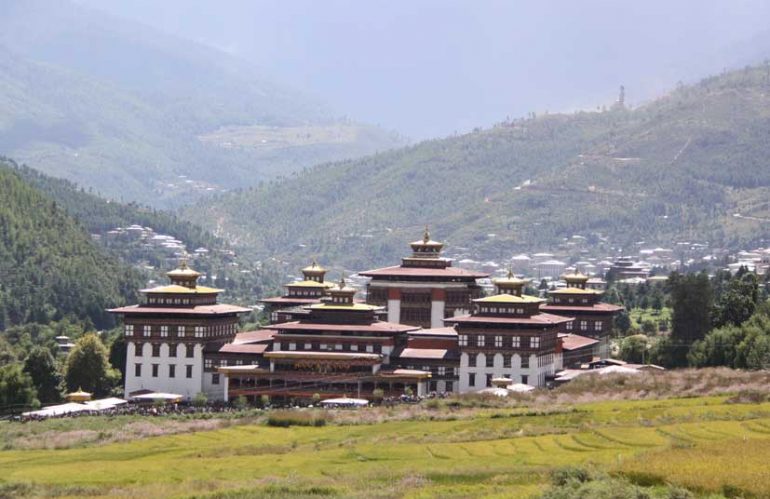Mines and Minerals
Bhutan has mapped and prospected only about 33% of the country in 1:50,000 scale. Past exploration has confirmed reserves of industrial minerals like limestone, dolomite, gypsum, quartzite, graphite, talc etc and metallic minerals like tungsten, lead-zinc and copper. There is potential for further discovery of minerals in the unexplored parts of the country.
Snap-shot of Minerals in Bhutan
| Sl. No. | Mineral | Location | Reserve (in million tones) and Grade |
| 1 | Copper ore | Gongkhola in Black Mountain area, Zhemgang Dzongkhag | 2.5 inferred, with 1.5% Cu |
| 2 | Lead zinc ore | Genekha area, Thimphu Dzongkhag | 3.116 in Chakula – proved
0.514 in Romegong Ri – probable |
| 3 | Tungsten ore | Dholpani and Bhurkhola, Gelephu Dzongkhag | 0.45 estimated down to 30 m depth in Dholpani |
| 4 | Coal | Deothang and Bhangtar, Samdrup Jongkhar Dzongkhag | Reserve very tentative |
| 5 | Dolomite | All along the foothill of Southern Bhutan
|
Huge reserve. Proved reserve will be rendered by DGM as and when required |
| 6 | Graphite | Khepchishi (above 3992m altitude) Paro Dzongkhag | 23.53 – proved by drilling |
| 7 | Gypsum | Khothakpa and Uri Chu, PemaGatshel Dzongkhag | 56.45 proved in Khothakpa
13.60 estimated in Uri Chu and Khar Remaining reserve much less, mining ongoing |
| 8 | Limestone | Pagli – Titi, Samtse Dzongkhag
Gholtey, Gelephu Dzongkhag Kanamakra, Gelephu Dzongkhag Korungri and Kerungri, Samdrup Jongkhar Dzongkhag |
Reserve almost exhausted by PCAL
Reserve being assessed Huge reserve of high grade limestone Huge reserve of cement grade limestone |
| 9 | Marble | Khanku, Paro Dzongkhag
In northern region of Bhutan such as Haa Wangtsa, Chelala in Paro, Jemina in Thimphu, Sha Bhel in Wangdiphodrang, Hasilo and Pangpeysa in Paro and Bunakha in Chukha Dzongkhag |
12.44 – proved
29.59 – probable
Reserve not proven |
| 10 | Slate | Bhel (Bonsegeoma) and Kobja in Wagdhiphodrang Dzongkhag | 16 million cubic meters. A large portion is already extracted for roofing purposes in Bhutan |
| 11 | Talc | All in the foothill belts in South West Bhutan | Reserve not assessed properly as the deposit is very erratic and patchy in nature |
| 12 | Ferro Silicon
Grade Quartzite |
Quartzite in Shumar Formation | Reserve not assessed systematically |
Note:
– The mineral reserves mentioned in the table above are only probable or inferred
– The minerals currently operated are talc, quartzite, dolomite, limestone, marble, coal, gypsum and granite.
Power Intensive Industries
Bhutan has, so far, tapped only about 7% of its potential 30,000 MW hydropower. By 2020 the installed capacity will reach 10,000 MW with a firm power of about 2000 MW. About 85% of the generation will be diverted to high voltage industries. Investment in power intensive industries remains attractive from this perspective.
Hospitality Sector
Bhutan’s tourism policy is guided by the principle of ‘high value low impact’. Government is promoting sustainable tourism throughout the country all year round by minimizing negative impacts and taking advantage of the country’s unique cultural and spiritual heritage as well as natural environment through high value tourism. The focus areas are nature based activities including wellness tourism, spiritual and MICE.
ICT
Bhutan is transforming into a knowledge-based society and developing a high-end service industry through ICT. Thimphu TechPark was also launched in November 2011. The TechPark offers a superior business environment for diverse technology sectors, including IT/ITeS, BPOs, KPOs and Research with Grade A infrastructure and amenities to occupants, such as mains and back-up power, with power available at under 30% of cost in other parts of the region. TTP also offers high-capacity dual feed Internet connectivity.
Education City
The Royal Government has the vision of establishing an Education City in Bhutan that provides world-class education targeting mostly regional expatriate students. The city is expected to be a 100% green campus with world-class facilities using sustainable technologies. About 1000 acres of land in addition to other incentives is to be provided by the Royal Government.
Renewable Energy
Clean energy has always been an integral component of the government’s development policy. Presently, Bhutan has made good progress from harnessing energy from run-of-the-river hydro power and sees potential also from alternative energy like solar, bio-mass and wind.
